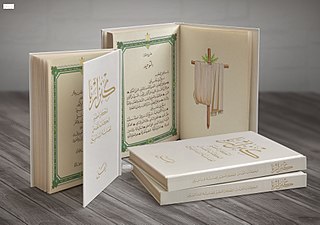
Mandaeans, also known as Mandaean Sabians or simply as Sabians, are an ethnoreligious group who are followers of Mandaeism. They believe that John the Baptist was the final and most important prophet. They may have been among the earliest religious groups to practice baptism, as well as among the earliest adherents of Gnosticism, a belief system of which they are the last surviving representatives today. The Mandaeans were originally native speakers of Mandaic, an Eastern Aramaic language, before they nearly all switched to Mesopotamian Arabic or Persian as their main language.

Elizabeth was the mother of John the Baptist, the wife of Zechariah and a relative of Mary, mother of Jesus, according to the Gospel of Luke and in Islamic tradition. She was past normal child-bearing age when she conceived and gave birth to John. She is revered as a saint by the Roman Catholic, Eastern Orthodox, Oriental Orthodox, and Lutheran churches, in addition to being a highly respected figure in Islam.

Mandaeism, sometimes also known as Nasoraeanism or Sabianism, is a Gnostic, monotheistic and ethnic religion with Greek, Iranian, and Jewish influences. Its adherents, the Mandaeans, revere Adam, Abel, Seth, Enos, Noah, Shem, Aram, and especially John the Baptist. Mandaeans consider Adam, Seth, Noah, Shem and John the Baptist prophets, with Adam being the founder of the religion and John being the greatest and final prophet.
The Haran Gawaita also known as the Scroll of Great Revelation, is a Mandaean text which recounts the history of the Mandaeans as Nasoraeans from Jerusalem and their arrival in a region described as "Inner Harran which is called the mountains of Madday", which some scholars have identified with Media. The Haran Gawaita continues the historical narrative of the Mandaean Book of Kings, adding a new eighth age to the seven described in that work.
In Mandaeism, the Book of John is a Mandaean holy book in Mandaic Aramaic which Mandaeans attribute to their prophet John the Baptist.
An uthra or ʿutra is a "divine messenger of the light" in Mandaeism. Charles G. Häberl and James F. McGrath translate it as "excellency". Jorunn Jacobsen Buckley defines them as "Lightworld beings, called 'utras ." Aldihisi (2008) compares them to the yazata of Zoroastrianism. According to E. S. Drower, "an 'uthra is an ethereal being, a spirit of light and Life."
In Mandaeism, ʿUr is the king of the World of Darkness or underworld. He is the son of Ruha, the queen of the underworld, and her brother Gaf, one of the giants in the World of Darkness described in book 5 of the Ginza Rabba. Ur is typically portrayed as a large, ferocious dragon or snake. He is represented by the image of a serpent on the skandola talisman.
In Mandaeism, Yushamin and also known as the 'Second Life', is the primal uthra and a subservient emanation who was created by the Mandaean God 'The Great Life', hence beginning the creation of the material world. Yushamin is the father of Abatur. Jorunn J. Buckley identifies Yushamin as "both a Lightworld utra beyond reproach and the prototype of a priest who has made mistakes in ritual."
In Mandaeism, Manda d-Hayyi or Manda ḏ-Hiia is an uthra sent by the Great Life as a messenger to John the Baptist. Manda d-Hayyi is considered to be the most important uthra, since he is the one bringing manda to Earth (Tibil).
In Mandaean cosmology, a maṭarta is a "station" or "toll house" that is located between the World of Light from Tibil (Earth). It has variously been translated as "watch-station", "toll-station", "way-station", or "purgatory". Maṭartas are guarded by various uthras and demons. Ruha, the queen of the underworld, is the ruler or guardian of one of the maṭartas.
Jorunn Jacobsen Buckley is a Norwegian-American religious studies scholar and historian of religion known for her work on Mandaeism and Gnosticism. She was a former Professor of Religion at Bowdoin College. She is known for translating the Scroll of Exalted Kingship and other Mandaean texts, as well as for her various books on the Mandaean religion and people. Her interests include Mandaean genealogy and anthropology.
In Mandaeism, Shitil is an uthra from the World of Light. Shitil is considered to be the Mandaean equivalent of Seth.
A Mandaean priest or Rabbi refers to an ordained religious leader in Mandaeism.

In Mandaeism, zidqa refers to alms or almsgiving. Mandaean priests receive regular financial contributions from laypeople, since priesthood is typically a full-time occupation. Zidqa is also offered to the poor and needy.
Ziwa is an Aramaic term that is typically translated as 'radiance' or 'splendor.' It is frequently used as an epithet for celestial beings and manifestations of God in Gnostic religions such as Mandaeism and Manichaeism.
In Mandaeism, Anush or Anush Uthra is an uthra from the World of Light. Anush is considered to be the Mandaean equivalent of Enos.
In Mandaeism, Sin or Sen is the Mandaic name for the Moon. Sin is one of the seven planets, who are part of the entourage of Ruha in the World of Darkness.
In Mandaeism, Shamish or Šamiš is the Mandaic name for the Sun. Shamish is one of the seven classical planets, who are part of the entourage of Ruha in the World of Darkness.
In Mandaeism, Yurba or Yorabba is an uthra. Lidzbarski spells his name as spelled Jōrabba. Yurba, who is also called the fighter, is identified with Shamish, the sun. In Mandaean texts, Yurba is often mentioned as engaging in conversation with Ruha. Gelbert (2013) also suggests that Yurba alludes to the historical Rabbula, a 5th-century bishop of Edessa.
Mandaean studies, or Mandaic studies when referring to linguistic studies, is the study of the Mandaean religion, Mandaean people, and Mandaic language. It can be considered as a subdiscipline of Aramaic studies, Semitic studies, Middle Eastern studies, and Oriental studies. Related disciplines include Syriac studies, Assyriology, Iranian studies, Jewish studies, and religious studies.





